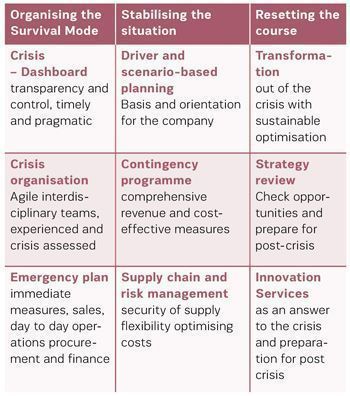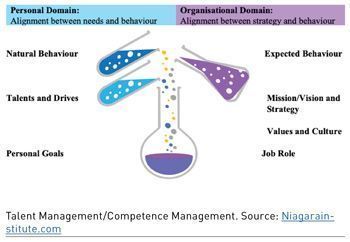HealthManagement, Volume 22 - Issue 5, 2022
Key Points
- VUCA is an acronym that stands for Volatility, Uncertainty, Complexity and Ambiguity.
- VUCA clearly sets the course for our current and future organisational challenges.
- VUCA Prime is a behavioural leadership model to counteract each of the four elements of VUCA with a specific positive response.
- Nowadays, education and personnel development need a competence management programme that is aimed at both the specific needs of individual employees and their roles in the company.
- Best practice was yesterday, best thinking is in demand, today and tomorrow.
Background
The framework conditions are changing – in society and at work. Driven by the shortage of skilled workers, many professionals today can choose their employer. The result is declining loyalty to the company, higher demands for meaningful work and a good work-life balance. Overall, it is important for companies and institutions to remain an attractive employer in the future and, at the same time, be able to cope with the drastic new challenges in healthcare.
What Does VUCA Mean?
VUCA is an acronym that stands for Volatility, Uncertainty, Complexity and Ambiguity. The term VUCA originated in the U.S. Army in the 1990s. It was used in the U.S. Army War College to describe the changes after the end of the Cold War. When the USSR collapsed, the American military suddenly had no clear-cut enemy. In addition to a loss of orientation, there were also major changes within the military and new ways of seeing and reacting emerged. Currently, the term is used to describe the difficult market environment that many executives are facing. To lead successfully in this context, one must be able to understand how the four challenges of the VUCA world affect companies and our daily professional work.

What Works and How to React as a Leader
In response to a VUCA world, Bob Johansen from the Institute for the Future, introduced first in 2007 the “VUCA Prime” model. VUCA Prime is a behavioural leadership model, to counteract each of the four elements of VUCA with a specific positive response. They are:
- Volatility vs Vision: Accept change. Build in “slack and wiggle room” for unaccounted issues.
- Uncertainty vs Understanding: Consider new viewpoints and invest time to understand the observed triggers and indicators. Monitor key metrics and add indicators of success and failure at every step. Have regular reviews and post-mortems. Perform what-if exercises to help train staff and get ready for unforeseen occurrences.
- Complexity vs Clarity Communicate clearly and frequently with all parties. Encourage collaboration between teams and groups. Identify areas where more insight is needed and address them. Build in fail-safe and backup systems (Heller 2019).
- Ambiguity vs Agility: Perform tests to bring clear understanding to ambiguous information. Be prepared to change as more information is discovered.
If you want to apply “VUCA Prime” holistically, this requires a transformation of the company and thus a cultural change. The healthcare system is now challenged because the big wave of digitalisation is still to come, and the shortage of skilled workers is increasing. Agile methods and mindsets provide efficient support to successfully shape change as an organisation, in teams or in projects (Montua 2020).
A typical approach to achieving these goals are small, interdisciplinary teams which work through a problem step by step over short cycles. These teams organise themselves to a significant extent. Planning meetings, in which the steps are defined, is an integral part of this method. In addition, there is regular self-reflection on the work in the team for continuous improvement. Teams and the entire organisation become more effective through this consistent focus on the respective goals - and through “flat hierarchies,” they also become more efficient.
The healthcare system is predestined for the application of agile methods. Interdisciplinary cooperation is essential and can be further supported. While specific goals and work functions are often still primarily given to the team, the change to an agile organisation can bring additional tasks, competencies, and responsibilities into the team. The chance of being involved as an individual increases and with it the attractiveness of the work.
Essentially, it is about focusing on people (in the team and on the client/patient), giving higher priorities to solutions rather than documentation, and reacting to changes rather than sticking rigidly to a plan.
What Leadership Skills are Needed
Vision Casting
Clearly defining the core value proposition of your organisation and how you and your team fit into it through your daily contributions is critical in times of change. Setting and communicating a shared purpose and vision, helps your team to understand the bigger picture. When everything is constantly changing, this shared purpose and vision is a pillar to keep coming back to.
Preparedness
Monitoring and tracking trends, competitors, and the business surrounding. Identifying patterns and variables which can impact your organisation and team. This can give you an early warning of possible impending change. If you incorporate this into your daily work life, you will be able to anticipate and prepare you and your team for change.
Flexibility and Adaptability
When times are uncertain and change is the norm, an ideal leadership is to be able to stay flexible and adaptable. In these times, leadership requires not to be stubborn in your way of managing and rigidly work to your annual plan. It is necessary to be able to flex, pivot and be agile as added information arises, decisions are made, and opportunities are taken.
Decision Making
In VUCA leadership, having a bias for action is critical. It is the ability to decide when you have incomplete information, cannot fully realise the complexity and interconnectivity of the decision being made, and experience cannot be relied on as this problem has never happened before. Leaders must accept that they are operating in an imperfect world, and they must make the best choice for their project, team, and organisation between action or inaction.
Collaboration and Teamwork
When leading through unprecedented times, innovative thinking, and idea diversity, which requires input across all functions and levels in the organisation, is needed to uncover fresh solutions. As there are no best practices when navigating through times of VUCA, facilitating collaboration among employees as a leader becomes all that more important, as everyone is needed to find innovative solutions and quickly adjust to the changing reality.
Customer/Patient/Client Focus
No matter what your function is in the organisation, having a customer-centric focus, on how external forces will impact the customer experience, at the forefront of decisions being made, is an essential component in leading in a VUCA world (Johansen 2012).
How to Deal With an Acute Crisis?
The following three steps will show how to organise, stabilise and reset the course in an acute crisis (Hellet 2019):
Methods for Education and Personnel Development
So far, the Human Resources Department has often formulated learning needs for groups of employees. The appropriate trainers were sought, and subsequently suitable digital formats were often created as further education and training catalogues. The design and implementation were often conducted by allocation according to functions and/or departments. A differentiated and individual needs-oriented personnel development did not take place across the board. Regular compulsory and refresher training courses have been certified by issuing certificates. A real acquisition of competence and the implementation in practice was rarely common.

Adapted Methods of Education and Competence Acquisition
Nowadays, education and personnel development need a competence management programme, aimed at both the specific needs of individual employees and their roles in the company. The previous methods and tools were not sufficient for this purpose. A competency management model integrated into the corporate philosophy is required. A dynamic economic, technological, social, and ecological environment forces every company to permanent adjustment and learning processes, especially with the focus on patients/clients and employees. In other words, this requires the consistent linking of company needs and employees as knowledge circulation (Schüler 2022).

Cognitive Apprenticeship
Cognitive Apprenticeship (“cognitive teaching”) is a method that aims to make cognitive processes visible to the learner in the sense of master-apprentice relationships. Attempts are made to use the advantages of practical training for theoretical training. The practical training should make the processes visible and tangible, which remain invisible in theoretical training. Cognitive Apprenticeship is suitable for designing the instructional component of work-oriented learning. The method of Cognitive Apprenticeship is illustrated.

Conclusion
VUCA clearly sets the course for our current and future organisational challenges. VUCA particularly challenges us as leaders and forces us to think about what and how business should be done. It describes the challenges we face in our private and professional lives. Business models, strategies and organisational models will have to be revised. Best practice was yesterday, best thinking is in demand, today and tomorrow.
Managers must focus on employees and enable them to do their jobs properly. As Charles Handy (1932) stated, “whereas the heroic manager of the past knew all, could do all, and could solve every problem, the post heroic manager asks how every problem can be solved in a way that develops other people´s capacity to manage it”.
Conflict of Interest
None.
References:
Hellet J (2019) Resilienz für die VUCA-Welt. Springer Verlag Wiesbaden.
Johansen B (2012) Leaders Make the Future. Berrett-Koehler-Publisher Inc. (Second Edition).
Montua A (2020) Führungsaufgabe interne Kommunikation. Springer Gabler Wiesbaden.
Schüller MA (2022) Bahn frei für Übermorgengestalter. Gabal Verlag, Offenbach.



